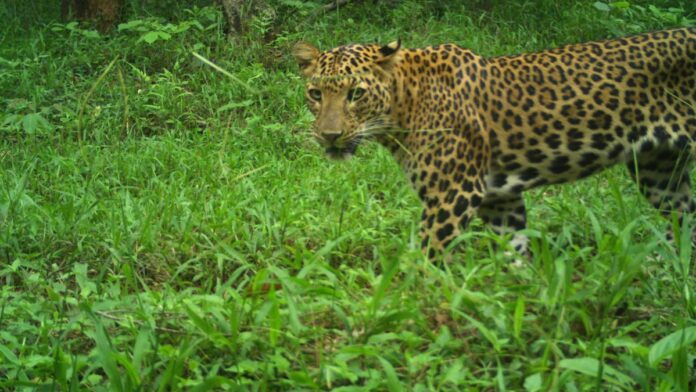
Leopards captured by cameras installed in different forests of Odisha.
| Photo Credit: SPECIAL ARRANGEMENT
In some good news for wildlife enthusiasts, Odisha’s leopard population has increased by 22%, rising from 568 to 696 in two years between 2022 and 2024, despite ongoing concerns about poaching and the illegal trade of leopard skins in the State.
The All Odisha Leopard Estimation 2024, released on Thursday (October 3, 2024), estimates the State’s leopard population to range between 668 and 724, with a median count of 696. However, the present leopard population lags behind the 2018 census carried out by the National Tiger Conservation Authority (NTCA), which put Odisha’s big cats number at 760. In 2022, the population dropped to 568.
The Forest department had conducted estimation across 47 forest divisions, aimed at much more intensive State-level leopard monitoring. A statewide field survey was also conducted to identify the presence of leopards through various signs, including pugmarks, scrapes, scats, rakes, urine spray, vocalisations, and livestock depredation.
Camera trap
“Sites with confirmed direct or indirect evidence of leopard were monitored using camera traps to estimate the minimum number of unique adult leopards based on their distinctive rosette patterns. Camera trap identification of leopard is a scientifically recognised method and is used in national-level leopard population assessments,” says the estimation report.
Susant Nanda, Principal Chief Conservator of Forest (Wildlife), said: “The big cat population is healthy. In 2022, the estimation was taken up in a limited area while we had taken up the estimation in much larger area capturing leopards in camera traps. We could discover many melanistic leopards in our forests.”
As per the latest NTCA report, the leopard population in India stands at 13,874. The leopard population has dwindled by 75-90% across the country over the last 120-200 years. According to Wildlife Protection Society of India, around 1,485 leopards were poached in the country in the last 10 years.
Poaching menace
As per the information furnished by the Forest and Environment department in the State Assembly, as many as 59 leopard skins were seized from wildlife smugglers between 2018 and 2023. Similarly, a Special Task Force (STF) of State police has recovered 57 leopard skins from poachers and wildlife article dealers from 2019 to 2024. Overall, 116 leopards were killed and skins were peeled off. Wildlife experts said in dozens of cases, leopard skins might have reached their destinations unnoticed and unintercepted.
Odisha’s forest cover accounts for 33.50% of the State’s total geographic area. The State government said there is one national park, 19 wildlife sanctuaries and two conservation reserves in Odisha.
The latest population estimate report says, “Protected areas proved to be the regions with the highest leopard abundance. Similipal Tiger Reserve has the largest leopard population in Odisha. Due to its extensive size, Similipal landscape plays a crucial role as a source population for leopards in the surrounding region. It is connected to Hadagarh Wildlife Sanctuary and Kuldiha Wildlife Sanctuary, which is essential for leopards to disperse from Similipal to these other protected areas.”
The report further states that Satkosia landscape turned out to be another promising site for leopards and boasts of the second highest leopard population in the State. Similarly, Hirakud Wildlife Division, which includes Debrigarh Wildlife Sanctuary, is another key habitat for leopards and has a significant leopard population.
“As high as 45% of the leopard population in Odisha is located outside the protected area network and thus the territorial forest divisions have considerable leopard presence. The rare melanistic leopard morph was recorded from three forest divisions,” it observes.
“From the next year, this camera trap based All Odisha Leopard Estimation exercise will be synchronised with the annual All Odisha Tiger Estimation exercise. This comprehensive exercise will involve collecting data on both the big cat occupancy, prey base estimation, and assessments of vegetation structure and human disturbance in the State,” the Forest department said.
Published – October 04, 2024 08:45 am IST










